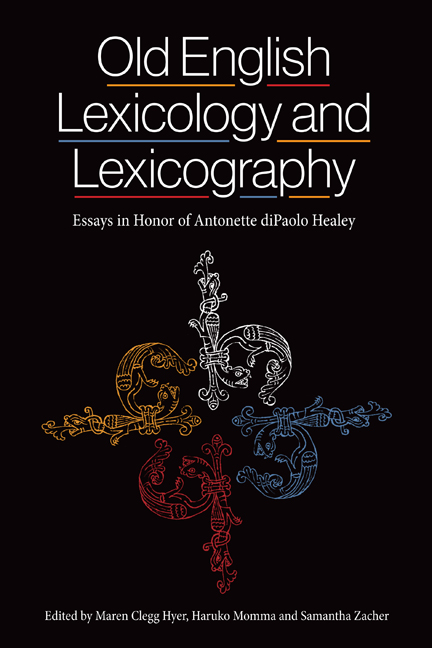Book contents
- Frontmatter
- Dedication
- Contents
- List of Illustrations
- List of Contributors
- Acknowledgements
- Abbreviations
- Introduction
- I Old English Poets and their Word-Craft
- 1 Beowulf and the Art of Invention
- 2 Juliana 53a Revisited (hætsð hæþenweoh)
- 3 Wounds and Compensation in the Old English Soul and Body Poems
- II Old English Homiletic Tradition
- 4 Defining and Redefining: Ælfric's Access to Gregory's Homiliae in Evangelia in the Composition of the Catholic Homilies
- 5 Lambeth Homily 4 and the Textual Tradition of the Visio Pauli
- 6 ‘A Vision of Souls’: Charity, Judgment, and the Utility of the Old English Vision of St. Paul
- 7 The Vocabulary of Sin and the Eight Cardinal Sins
- III Anglo-Saxon Institutions
- 8 The King (and Queen) and ‘I’: Self-Construction in Some Anglo-Saxon Royal Documents
- 9 Anglo-Saxon Maccabees: Political Theology in Ælfric's Lives of Saints
- 10 Nunne in Early Old English: Misogyny in its Literary Context
- IV Lexis of the Quotidian
- 11 Cingulum est custodiam: Semiotics and the Semantic Range of gyrdels
- 12 Island Time: The English Day and the Christian Hours
- 13 ‘Revising Hell’: The Voices of Teachers in Anglo-Saxon Studies and Anglo-Saxon England
- V The Task of the Lexicographer
- 14 Cryptography and the Lexicographer: Codifying the Code
- 15 Genre and the Dictionary of Old English
- Epilogue: Word-Hord
- 16 Reading Beowulf with Isidore's Etymologies
- An Old English Lexicon Dedicated to Toni Healey
- Toni Healey: A Tribute
- List of publications of Antonette diPaolo Healey
- Index
- Tabula Gratulatoria
- Miscellaneous Endmatter
- Anglo-Saxon Studies
1 - Beowulf and the Art of Invention
Published online by Cambridge University Press: 17 September 2020
- Frontmatter
- Dedication
- Contents
- List of Illustrations
- List of Contributors
- Acknowledgements
- Abbreviations
- Introduction
- I Old English Poets and their Word-Craft
- 1 Beowulf and the Art of Invention
- 2 Juliana 53a Revisited (hætsð hæþenweoh)
- 3 Wounds and Compensation in the Old English Soul and Body Poems
- II Old English Homiletic Tradition
- 4 Defining and Redefining: Ælfric's Access to Gregory's Homiliae in Evangelia in the Composition of the Catholic Homilies
- 5 Lambeth Homily 4 and the Textual Tradition of the Visio Pauli
- 6 ‘A Vision of Souls’: Charity, Judgment, and the Utility of the Old English Vision of St. Paul
- 7 The Vocabulary of Sin and the Eight Cardinal Sins
- III Anglo-Saxon Institutions
- 8 The King (and Queen) and ‘I’: Self-Construction in Some Anglo-Saxon Royal Documents
- 9 Anglo-Saxon Maccabees: Political Theology in Ælfric's Lives of Saints
- 10 Nunne in Early Old English: Misogyny in its Literary Context
- IV Lexis of the Quotidian
- 11 Cingulum est custodiam: Semiotics and the Semantic Range of gyrdels
- 12 Island Time: The English Day and the Christian Hours
- 13 ‘Revising Hell’: The Voices of Teachers in Anglo-Saxon Studies and Anglo-Saxon England
- V The Task of the Lexicographer
- 14 Cryptography and the Lexicographer: Codifying the Code
- 15 Genre and the Dictionary of Old English
- Epilogue: Word-Hord
- 16 Reading Beowulf with Isidore's Etymologies
- An Old English Lexicon Dedicated to Toni Healey
- Toni Healey: A Tribute
- List of publications of Antonette diPaolo Healey
- Index
- Tabula Gratulatoria
- Miscellaneous Endmatter
- Anglo-Saxon Studies
Summary
The creativity of the Beowulf-poet is a byword, and it is easy to be so dazzled by the poet's artistic excellence that the mechanics of his craft are obscured. Yet the Toronto Dictionary of Old English, especially under the energetic editorship of Toni Healey, has made available precisely the tools to examine in meticulous detail what makes the Beowulf-poet's technique tick, both through the Corpus and the Dictionary itself. Complementing the DOE, another more recent project, A Consolidated Library of Anglo-Saxon, will offer a combined corpus of Old English and Anglo-Latin poetry, with complete texts and translations, and a series of interlinked databases mapping (for example) rhythm and metre; alliteration; rhyme and assonance; poetic vocabulary; hapax legomena and compounds; syntax and structure; formulas and formulaic systems; themes; parallels and echowords; direct sources; emendations and scribal corrections; and editorial variants. This essay makes extensive use of both DOE and CLASP, especially the latter's database of compounds, to demonstrate how both projects can be employed in tandem.
The poet's skill is evident throughout Beowulf, but in this context it seems particularly pertinent to consider the four main descriptions of poetic performance and associated verses, spread out over more than 2,000 lines, and increasing in length (Beowulf [hereafter Beo] 89b–91, 867b– 74, 1063–70, and 2105–14). In each case, rather ominously occurring beforethe advent of monstrosity (the kin of Cain, Grendel, Grendel's mother, and the dragon respectively), these descriptions are tightly intertwined by verbal echoes and other parallels. The first and briefest occurs early in the poem, describing the celebration that followed the building of Heorot, a paean performed by one of Hrothgar's poets (Beo 89b–91: here and below, parallels between relevant passages are indicated in bold italics):
Þǣr wæs hearpan swēġ ,
swutol sang sċopes. Sæġde sē þe cūþe
frum-sċeaft fīra feorran reċċan[…]
There was the harmony of the harp, / the clear song of the poet. He spoke, who could / recount from far back the beginnings of men […]
- Type
- Chapter
- Information
- Old English Lexicology and LexicographyEssays in Honor of Antonette diPaolo Healey, pp. 19 - 36Publisher: Boydell & BrewerPrint publication year: 2020

